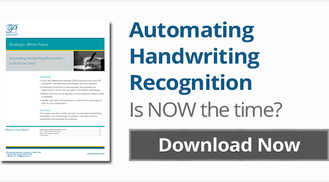Despite tremendous gains in process efficiency, paper is still a crucial medium for bridging external and internal processes; which could be as simple as taking a new customer application and entering it into a computer.
With rising labor costs and competitive pressures for faster customer service, automation of data extraction from paper is becoming crucial to businesses, organizations and government agencies that process huge volumes of forms, applications, checks and other documents. These factors have led to the continued growth of document capture and electronic content management (ECM) solutions, as well as recognition solutions (OCR & ICR), which are critical to automating the extraction of content from paper forms and documents.
The United States Postal Service has used OCR scanners to sort mail since the 1960s. Since printed characters and fonts are standardized, OCR can easily and accurately identify and convert data. However, OCR is constrained to machine print text only, which significantly limits its application.
ICR is a more advanced technology that reads handwriting, which may include constrained and unconstrained handprint, in addition to cursive script. This is a significantly more complicated technical challenge since handwriting is unique to each individual.
Despite the value offered by these technologies, adoption rates are still relatively low. As a result, there is an opportunity to gain an advantage over competition. By automating and improving the time it takes to process inbound forms, organizations can provide better customer service and lower their costs.
Download the white paper Automating Handwriting Recogniton Is Now the Time? to learn more about automated handwriting recognition, its current state of adoption, and key points to understand and evaluate this software.

